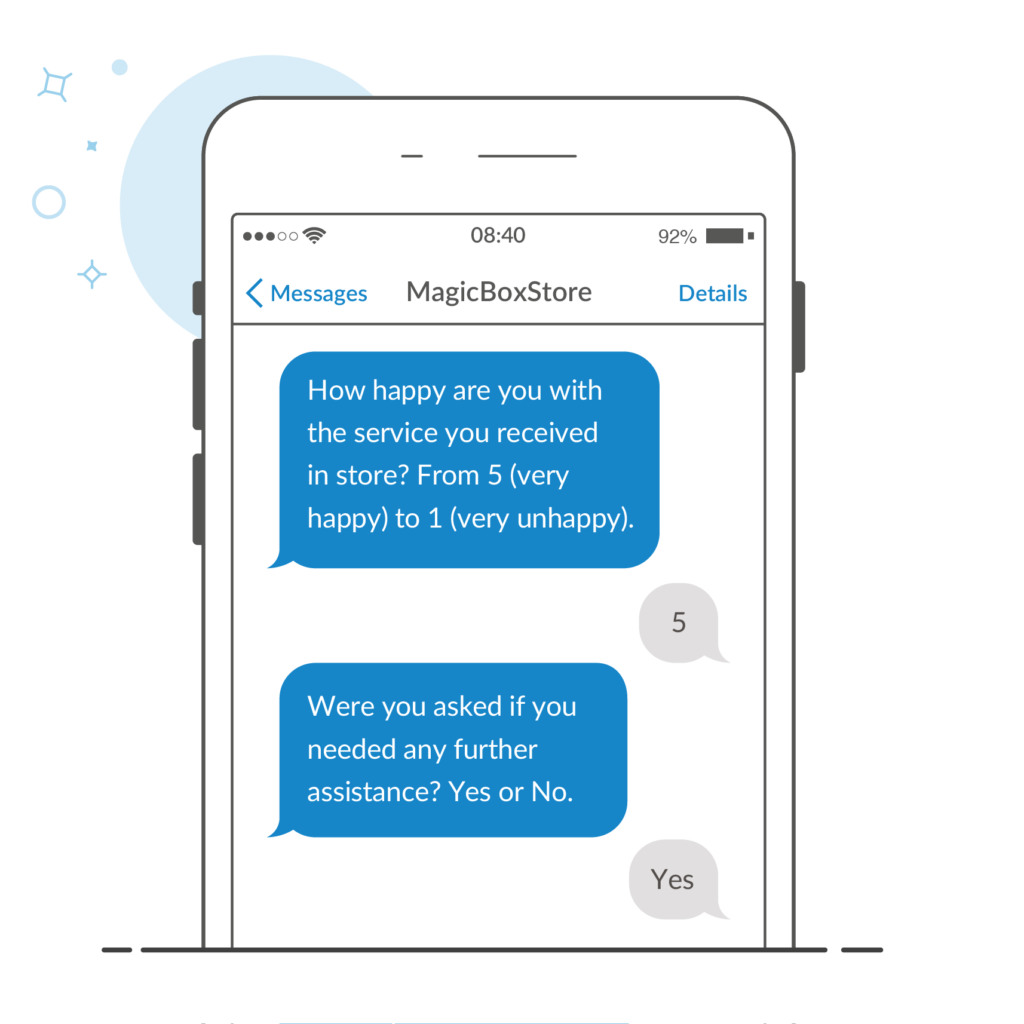Engage customers and staff and make informed business decisions with instant feedback from SMS Surveys…
SMS surveys can help you to engage your customers and staff, gather instant feedback, improve customer experience and gain a fresh perspective on the business challenges you face.
Learn why they can be such a useful tool and how to get started in our guide below.
What are SMS surveys?
SMS surveys shrink down the traditional questionnaire into a two-way text conversation, with one survey question at a time sent to the recipient’s mobile phone or device.
Best of all they are convenient for recipients, who can respond in their own time and often find the personalised, quick-fire questions easy to engage with. And the higher response rates make it a cost-effective way for businesses to gather fast and valuable feedback and insights.
You might choose to send these to your customers or your staff depending on what type of feedback you are looking for.
Here’s an example of what this interaction could look like with your customers:

How to plan and create an SMS survey
There are three main steps to planning and creating an effective SMS feedback survey:
1. Decide on the survey type
Before you start, have a clear goal to work towards by defining a survey type. To do this think about what you’re trying to find out, or the problem you’re trying to solve.
Some common SMS survey types include:
- Market research surveys – allows you to gather information about customer perceptions and preferences, brand awareness and the competitive landscape.
- Lead generation surveys – helps you to grow your business – they give you a list of prospects and help you gauge their interest in your products or services.
- Brand awareness surveys – helps to reveal how customers really see you, how effective your marketing and promotions have been and where you could improve.
- Customer satisfaction surveys – tells you how happy people are with your company and products or services and are useful in nurturing loyalty and retention.
- Event feedback surveys allows you to collect attendees’ opinions and help shape future events.
- Employee surveys – these may take the form of new-hire surveys, employee satisfaction surveys, training evaluation surveys or exit interviews.
2. Build your participant list
You can send your survey to any contacts you already have, providing they’ve opted in to receive SMS from your company. To grow your database, you could add a tick-box feature for customers to opt in to messages at the point of online purchase. You can also obtain contacts from SMS survey software providers.
Learn more: How to collect phone numbers for SMS marketing
3. Craft your questions
To get meaningful, actionable survey data, you need to write your questions carefully. The SMS format lends itself to quick-fire questions, using straightforward language so there’s no room for misinterpretation.
For ease of responding and to avoid ambiguity, you might want to stick to mainly yes / no (or true / false) questions. A Net Promoter Score (NPS), which measures satisfaction and loyalty on a scale of 1-10, can also be useful.
Start sending SMS surveys
Examples and when to use SMS surveys
The best time to use SMS surveys depends on how it fits into the bigger picture.
Feedback and insights are invaluable when there are big decisions to be made – for example about the future direction of your business, brand, product range or communication strategy.
But feedback requests can be a more regular thing too. As long as you’re not bombarding people or taking up too much of their time, routine surveys – triggered whenever the customer makes a purchase or calls customer services, for example – can be a valuable part of your ongoing customer retention strategy.
Asking for feedback in this way can help you make continuous improvements as your business grows and gives you an opportunity to respond quickly to individual customer concerns and complaints. It can also help to create loyalty, particularly if you can demonstrate that you act on customers’ feedback.
Some examples of when you might use SMS surveys include:
To measure customer loyalty
When you consider that winning new business can cost five to seven times more than retaining an existing customer, any opportunity to build loyalty and learn more about your customer base is worth taking. SMS feedback surveys are quick, non-intrusive, and get a great response rate.
Determining product viability
SMS surveys are cost-effective and yield high response rates, making them especially useful when you need a large sample size to understand the market.
Improving employee wellbeing
Staff surveys can boost morale, open the lines of communication and support new ideas. They can also serve as an early warning system, helping you to identify and swiftly rectify any problems or concerns across the organisation.
Planning events
From menu choices to access requirements, SMS is a quick and convenient way to manage attendee preferences ahead of big events. Responses can be stored and shared easily to keep everyone informed and ensure the event runs smoothly.
Cleaning up your database
Many businesses struggle with out-of-date or inaccurate customer data. SMS surveys are a cost-effective way to keep your database current. A simple text is much less intrusive than a phone call and means customers can respond at a time that suits them.
What are the benefits of using SMS for surveys?
There are a number of benefits to choosing SMS as the channel for your surveys – some of the main ones include:
Higher engagement
The fast and familiar format of SMS means you can expect consistently high engagement compared to other communication channels, such as email.
Fast responses
With SMS, recipients receive notifications instantly – and generally open and read them in minutes. It’s great for getting feedback on things that have just happened, like an event or customer service call, when it’s at the forefront of the recipient’s mind.
Scale and reach
SMS has huge reach and doesn’t require an internet connection, making it accessible to more people. Our powerful survey tool fits with your existing workflows and processes, making it easy to manage surveys at scale.
Meaningful insights
You can use analytics to extract actionable insights from survey data, including trends, patterns, and areas for improvement.
Cost efficient
Given the typical open and response rates of SMS, it’s extremely cost-effective. The more messages you send, the cheaper they become.
Top tips for sending SMS surveys
1. Maximise engagement
Make sure you introduce yourself by having an opening message with a sender identity your recipients will recognise. When it comes to questions keep them numbered (to indicate how far through the survey the recipient is) and to the point.
Aiming for a maximum of 4 to 5 questions will maximise your response and completion rates and therefore improve the quality of the results.
2. Personalise
Depending on your target audience you should include merge data to personalise the survey for each recipient – their name, the event they attended, the product they purchased etc.
This should achieve a higher volume of responses and better quality feedback as recipients feel more engaged.
3. Vary responses & encourage interaction
To combine both quantitative and qualitative insights from your survey, it’s a good idea to use a branched survey. This allows you to show a different follow up question depending on the recipient’s response, so that you are asking questions relevant to the responses provided.
For example, if a recipient rated you 9 or 10 out of 10, then the next question might be to find out if they would buy again. If the recipient had a bad experience, you can instead find out what went wrong and take action to ensure this does not happen again.
4. Timing is everything
The speed in which your SMS Surveys are sent is a big factor in responses. Make sure you’re asking your next question within 5 seconds of a response being received to create a conversation.
Consider your audience and determine the best times to gauge their opinion. Sending out an SMS Survey at 8:00 AM to a demographic who largely work office hours may not achieve the best results, whereas lunch time would be the perfect time to catch your audience while they have time to look at their phones.
If you have a development team who can work with you to automatically send a survey after a purchase or service provided, catching people while the experience is fresh in their minds is also a sure-fire way to increase response rates.
5. Incentivise your SMS Survey
Whether through a competition, discount or limited-time promotion, further your response rates by offering an incentive for your customer’s valuable time and feedback.
In summary
So in summary, are SMS surveys worth sending? It’s a resounding yes!
Fast, engaging and super convenient, they allow you to interact with your customers on a one-to-one level – while gathering feedback at scale.
To get started check out our SMS surveys page or get in touch to talk about your requirements with a member of our expert team.


